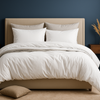Pillow Guide UK: The Right Loft & Fill for Side, Back & Front Sleepers
- by Anthony West
Pillow Guide UK: The Right Loft & Fill for Side, Back & Front Sleepers
Neck ache, numb shoulders, or waking up to re-fluff your pillow? This UK-focused guide shows you how to pick the correct height (loft), firmness and fill for the way you sleep—so your head and neck stay aligned all night.
Why Pillow Height (Loft) Matters
Your goal is a neutral spine—ears stacked over shoulders—so muscles can relax. The right pillow fills the gap between your head/neck and the mattress without bending your neck up or down.
- Side sleepers: need higher loft + medium/firm support to bridge the shoulder width.
- Back sleepers: need medium loft + medium support to keep chin from tilting forward.
- Front (stomach) sleepers: need a low loft + soft pillow—or sometimes no pillow—to avoid neck twist.
Tip: Your mattress and body shape change the ideal loft. A softer mattress lets your shoulder sink, reducing the loft you need; broader shoulders require more.
Quick Chooser: Loft & Firmness by Sleeper Type
| Sleeper Type | Loft | Firmness | Notes |
|---|---|---|---|
| Side | High (≈ 12–15 cm when compressed) | Medium-Firm / Firm | Great with gusseted or shaped pillows for edge-to-edge support. |
| Back | Medium (≈ 9–12 cm) | Medium | Look for a slight neck contour or a pillow that doesn’t pancake. |
| Front | Low (≈ 6–8 cm) | Soft | Consider a soft, flat pillow or hug a side pillow to reduce neck twist. |
| Mixed/Combo | Adjustable | Adjustable | Choose adjustable-fill or a responsive foam/latex that adapts. |
Shop by sleeper type: Snuggery Pillows · Pillow Protectors · Pillowcases
Pillow Fill Types (Pros & Cons)
Down & Feather
Down clusters give airy, cloud-like softness; feather adds structure. Look for high fill-power down and boxed construction to minimise shifting.
- Feel: Plush, mouldable; luxurious “sink-in”.
- Best for: Back/front sleepers who like soft support; side sleepers can use chambered designs with a supportive feather core.
- Pros: Light, breathable, long-lasting with care.
- Consider: Not ideal for some allergies; needs regular fluffing; prefers large-drum drying.
Microfibre / Hollowfibre
Modern synthetics engineered to mimic down at a friendly price, often labelled “hypoallergenic”.
- Feel: Soft to medium, springy; easy-care.
- Best for: All positions—choose loft/firmness accordingly.
- Pros: Machine-washable, quick-drying, allergy-friendly.
- Consider: Can compress faster than premium down/latex; choose higher-denier or spiral fibres for durability.
Memory Foam
Viscoelastic foam that softens with heat/pressure, then slowly rebounds.
- Feel: Contouring, slow-response; excellent pressure relief.
- Best for: Side/back sleepers needing shape support; great in contour shapes for neck alignment.
- Pros: Keeps loft; good for persistent neck pain when height is right.
- Consider: Warmer feel; “hug” sensation; check for low-odour, certified foams.
Latex (Natural or Blended)
Buoyant, springy foam tapped from rubber trees (natural) or blended. More breathable than memory foam.
- Feel: Responsive support; lifts rather than hugs.
- Best for: Side/back sleepers; great for combo sleepers thanks to quick rebound.
- Pros: Durable, breathable, resists flattening; naturally hypoallergenic and dust-mite resistant.
- Consider: Heavier; firm options can feel “bouncy”.
Wool
Lofty layers of wool provide gentle support with superb moisture management.
- Feel: Cushioned, temperate; great year-round.
- Best for: Hot sleepers; those wanting natural materials.
- Pros: Breathable, odour-resistant; regulates temperature.
- Consider: Needs occasional refluffing; usually spot-clean.
Adjustable Fill (Shredded Foam, Microfibre, or Mix)
Zip-open pillows you can add/remove fill from to fine-tune height.
- Feel: Customisable; can mix soft & firm zones.
- Best for: Combo sleepers; uncertain buyers; changing needs.
- Pros: One pillow fits many; reduces return risk.
- Consider: Keep spare fill; re-fluff occasionally to prevent clumping.
Match Pillow to Mattress & Body Shape
- Softer mattresses: Your shoulder sinks more when side sleeping → choose slightly lower pillow than you expect.
- Firmer mattresses: You rest higher on the surface → choose higher loft for side sleeping.
- Broad shoulders: Need extra loft; consider gusseted pillows (side walls 3–5 cm) to keep edge height consistent.
- Petite frames: Lower loft often better for back/stomach.
Pillow Sizes & Cases (UK)
| Size | Dimensions (Approx.) | Use | Case Type |
|---|---|---|---|
| Standard | 48 × 74 cm | Most beds; ideal as primary pillow | Housewife (edge-to-edge) or Oxford (bordered) |
| Super King | 50 × 90 cm | Wider support on King & Super King beds | Great for reading in bed; elegant hotel look |
| Square Euro | 65 × 65 cm | Decor + back support | Layer behind standards for height and style |
Finish with the right case: Percale (cool & matte), Sateen (silky sheen), or Linen (airy & textured).
Care & Hygiene
- Use a protector: Shields from sweat, makeup and hair oils; wash fortnightly with your cases.
- Washing: Follow label. Many microfibre pillows are machine-washable; down needs large-drum washing/drying; foam cores are usually spot-clean only (wash the cover).
- Refresh: Air pillows monthly; sun helps deodorise. Tumble synthetic/down with clean dryer balls to re-loft.
- Replace: Typically every 2–3 years (synthetic), 3–5 years (down/latex) depending on care and quality.
- Allergy tips: Choose tightly woven cases (e.g., 300 TC+) and wash hot occasionally to reduce dust mites.
Common Sleep Goals & What to Buy
- I wake with a stiff neck: Try a contour memory foam or latex pillow in the correct loft for your position.
- I run hot: Choose latex or wool, or breathable microfibre with a percale case; avoid very dense foam.
- I change positions: Go adjustable fill or a responsive latex pillow that rebounds quickly.
- I like a plush hotel feel: Choose down/feather or a premium “down-like” microfibre with a soft sateen case.
Shop Pillows by Sleeper Type Add a Pillow Protector
One-Minute Pillow Finder
Mostly side sleeping? High loft (12–15 cm) + medium-firm support. Consider gusseted microfibre, latex, or chambered down.
Mostly back sleeping? Medium loft (9–12 cm), medium support. Try latex or a stable microfibre/down blend.
Mostly front sleeping? Low loft (6–8 cm), soft. Choose soft microfibre or soft down, or sleep without a pillow.
Rotate a lot? Adjustable-fill pillow—remove/add to taste.
FAQs
How do I measure pillow loft at home?
Place the pillow on the bed and rest your head/neck as usual. Have someone take a side photo: your nose should point straight up, not angled. If your neck tilts down, raise loft; if up, lower it.
What’s better for neck pain—memory foam or latex?
Both can work when height is right. Memory foam cradles; latex lifts and keeps you aligned if you move at night. If you overheat on memory foam, try latex.
How many pillows should I sleep with?
Most adults sleep best with one correctly sized pillow. Side sleepers may add a knee pillow to keep hips aligned.
Are feather pillows bad for allergies?
Not always. High-quality, well-encased down/feather can be comfortable for many. If you’re sensitive, choose hypoallergenic microfibre or latex, and wash cases/protectors frequently.
When should I replace my pillow?
If it stays flat after fluffing, smells musty, or you wake with neck/shoulder pain despite proper loft, it’s time—often 2–3 years for synthetic, longer for latex/down with good care.
Build a Better Bed
Complete your setup for deep, restorative sleep:
- Choose the right duvet tog for UK seasons.
- Pick your sheet feel—cool percale, silky sateen or airy linen.
- Add a mattress topper to fine-tune firmness and pressure relief.



